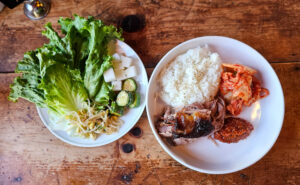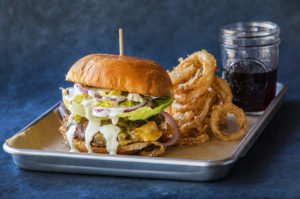 The extraordinary potato: A poisonous, inedible plant whose tuber provides one of the world’s most critical food sources and is equally at home in a Michelin-star kitchen as it is in a McDonald’s fry basket. whose Personally, I love potatoes. I mean, I really, really, love them. I could probably eat an entire meal consisting entirely of potatoes and enjoy it (at least, with enough fat and salt – one of the potatoes many desirable properties is its gustatory affinity for fat and salt). I love potatoes mashed, grated and fried into pancakes; diced and roasted as home fries; baked, oven-roasted, and, of course, deep-fried into French fries. Is there any food that is simultaneously simpler and more spectacular than a perfectly french-fried potato? I, for one, think not; but deep-frying at home is both suboptimally unhealthy, and more than a little dangerous, which is why I was so excited to discover that one can make exceptional fries in the oven (recipe & technique are described at the bottom of this post).
The extraordinary potato: A poisonous, inedible plant whose tuber provides one of the world’s most critical food sources and is equally at home in a Michelin-star kitchen as it is in a McDonald’s fry basket. whose Personally, I love potatoes. I mean, I really, really, love them. I could probably eat an entire meal consisting entirely of potatoes and enjoy it (at least, with enough fat and salt – one of the potatoes many desirable properties is its gustatory affinity for fat and salt). I love potatoes mashed, grated and fried into pancakes; diced and roasted as home fries; baked, oven-roasted, and, of course, deep-fried into French fries. Is there any food that is simultaneously simpler and more spectacular than a perfectly french-fried potato? I, for one, think not; but deep-frying at home is both suboptimally unhealthy, and more than a little dangerous, which is why I was so excited to discover that one can make exceptional fries in the oven (recipe & technique are described at the bottom of this post).
It is to the humble tuber’s credit that it remains edible, if perhaps not at the peak of flavor, days, weeks, even months after it is pulled from the ground; certainly, the ease with which potatoes can be stored played a material role in wintering over food supplies prior to the advent of refrigeration, particularly in Europe (Europeans still produce the most potatoes per capita, but the fastest rate of change is in Asia, and China is now the world’s leading producer). As usual, lots of good info here at Wiki, and if you’re really in a potato mood, check out the British Potato Council (how can you not love the Brits for this sort of thing?). The catch is that storage comes at a cost – once the potato begins to decompose, however slowly, the starches that are so essential to its culinary properties begin to break down, and texture and flavor are compromised – so whenever you find truly farm-fresh taters (and you have to ask, even at the farmer’s market – I used to see last-season’s crop for sale at the Union Square market in NYC all the time, when the stalls were otherwise lean), then by all means, you must buy them, and cook them post-haste.
I buy local spuds from several farmers, including Bernier Farms and Love Farms, but I’m particularly partial to the Yukon Golds from Foggy River Farms: On a good day, heaped in their baskets and camouflaged in clods of dirt, they still seem to hold the warmth of the topsoil they were unearthed from, although that seems unlikely, given the cool weather we’ve had. Regardless, hatched from the ground only hours earlier, they are irrefutably gorgeous in their filthy splendor, and an open invitation to make yummy things with hot fat and some fancy salt.
Hot fat, however – and French fries, specifically – present the home cook with a few obstacles, notably deep-frying (messy, dangerous, and requiring special equipment), and health (fat, fat, and more fat; although I’m not really very concerned with fat per se, the health issue having more to do with the types of fat and total calories consumed rather than the percentage or grams of fat in isolation, it’s still the case that anything I pull from a fryer is headed for my belly). Inspired by Heston Blumenthal’s approach to oven-roasted potatoes, I’ve been experimenting with “oven fries” for years now, with both greater and lesser success, and I’ve now convinced myself that a good – no, an excellent – oven fry is possible, even likely, with relatively little effort, and not much guilt on the health front.
Oven Fries
- Start with proper potatoes. If you’re going to go the trouble, and bear the caloric consequences, of making and eating home-made fries, surely it’s worth a good potato. Most important is that the potato be of the waxy variety, and ideally fresh from your favorite local grower’s patch of dirt. My go-to waxy potato is the Yukon Gold, great flavor, texture, color, and you can almost always find them.
- Pre-heat the oven to 450F and boil a pot of salted water that is large enough to accommodate all the fries without crowding. (If you don’t know how to salt water, go with the Italians’ advice for pasta: It should taste about like the sea – this works for pasta, vegetables, whatever.)
- While everything else is getting hot, proceed to wash, peel and then cut the potatoes into roughly rectangular shapes, dropping the cut fries into a large bowl of cold water. You will waste a bit, but reserve the trim; we’ll use the trim in the cooking, and it’s vitally important to start with the right shape: A bit oblong is fine, as length is not so critical; what is essential is that the four “sides” of your potato are parallel, so that you can subsequently cut it into fries of uniform thickness. Cut the potatoes into planks of uniform thickness, typically 5-10mm per side; I like about a 1/4″, but, while this is a matter of preference and aesthetics, cooking times and temps must be adjusted. Take the planks and stack them and cut them into sticks of width equal to their height – this will give you nice fries of uniform thickness, a pleasing square shape, and – most importantly – equal cooking time. As you cut the sticks, drop them into a bowl of cold water; this will help rinse starch off their surfaces and prevent them from sticking together.
- Wrap the trimmings in cheesecloth and drop it into the boiling water and dump the potato sticks into the boiling water for long enough to blanch – carefully! Use a slotted spoon or something to avoid splatter – and cook for about 5 minutes. 5 is my number, for my size fry (pictured); it will vary, from 3-8 minutes or so, so you need to watch them. They should come out just barely tender, but not at all falling apart – if they don’t ‘bend’ at all when you pluck one out, they’re not ready; if they start breaking or fail to hold their clean-cut shape, they’re over. This step is critical: There is no such thing as a decent fry that has been cooked only once. There is no short cut. You can use water, as I do here, instead of oil (not quite as good, but still quite good, and much healthier, easier, less messy, and safer at home), but you MUST blanch them before frying, or your fries are destined to suck. Seriously. It has everything to do with giving the starch molecules in the outer layer time to glue together before frying, which is what creates a crisp crust and a flaky interior. The chemistry is unforgiving on this, you can take my word for it, consult McGee, Corriher, or this excellent discussion from the French Culinary Institute, or you can eat shitty fries.
- Gently – gently – drain, rinse, and pat-dry the potatoes (laying them out on a kitchen towel which you then fold over works well). Transfer to a large bowl and coat them liberally with good-quality olive oil. When in doubt, keep it local – I’m still working through the bottom of a bottle of TJ’s Spanish EVOO, but I’d prefer to have used DaVero’s 40-weight. And when I say liberally, I mean it, now is not the time to skimp on fat. The fries should be coated and glistening with oil.
- Transfer to a sheet tray, moving the fries around to ensure that they all have room to breathe. Don’t “crowd” the tray! Transfer the sheet tray to the 450-degree oven and bake for about 20 minutes. Watch, listen, and check them frequently from 15 minutes on, but I suspect you’ll find about 25 minutes total cooking time.
- Take them out and salt the hell out of them. Nothing worse than a bland, under-seasoned french fry. Kosher salt is a staple around here, but sometimes it doesn’t stick to fries very well, so a finer grind of good sea salt, or – better – one of the more powdery sel gris would really make them sing.
- Serve IMMEDIATELY! Heinz (and no other) ketchup, or – better – a home-made aioli, would be unimpeachable, but is purely optional.
Good vittles…









